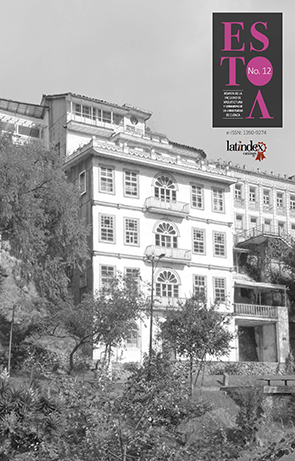The breeding of living landscapes as a detonant of its transformations. The case of Cotogchoa
DOI:
https://doi.org/10.18537/est.v007.n012.a03Abstract
The lecture will define intercultural landscapes, living landscapes and the way they "breed" contributing to physical, social and attitudinal changes in the rural parish of Cotogchoa. The tasks, searches and conceptualizations are built with actions, research, academic and teaching proposals from the Living Landscapes Laboratory of FADA-PUCE; through processes of participatory design between the academy and the community since 2014.
Cotogchoa is a vulnerable rural parish due to the uncontrolled growth of the urban mark of Quito, which has moved an industrial strip to the edges of the latter. This circumstance and the regulations about the size of the lot prioritize the urban situation on the rural characteristics of the area, favoring the densification and urbanization of agricultural land. The proposal is development to contribute to the characterization, valuation and recovery of local identities by reinforcing relationships and links between "living landscapes" rescuing traditions and celebrations, as well as alternative territorial planning in an Andean region with multiple conditions: physical, cultural, ethnic and diverse thoughts.
The laboratory through workshops of identity, participative design, consultancies, experiences and celebrations, has investigated the cultural dimension of the parish. This knowledge has empowered its inhabitants on attitudes and awareness in the preservation of their original rural vocation by establishing a space for negotiation in the face of urban overflow. It has evidenced and potentiated affects, relationships and links between living landscapes, exposing an evaluation system based on records that shows the fragility of the territory in front of the transformations of the urbanization process. Critical-perceptual maps and cartographies, community-driven, academic-community projects, creative-educational workshops, exhibitions and events that consolidate the upbringing of living landscapes are highlighted as instruments of mediation and criticism.
These spaces of action, dialogues and evaluation have generated in the community attitudes against the urban dynamics of "badly created landscapes" that deteriorate the habitat in rural areas. The actions and approaches between academy-community have awakened the desire to promote and strengthen local affective bonds, to preserve their cultural dimension, to foster spaces of exchange and communication and to investigate in the system of relations of landscapes that safeguard protected areas, conservation and imminent intervention.
Keywords: Intercultural landscapes, living landscapes, breeding, valuations, Participatory design.Downloads
References
BAUSELA, Esperanza. (2008). La docencia a través de la investigación-acción. http://rieoei.org/deloslectores/682Bausela.PDF.
BORJA, K. (2012). Criar paisajes vivos, una manera de aprehender los paisajes andinos. El caso de San Isidro de El Inca. (Tesis doctoral). Universidad del País Vasco. San Sebastián, España.
BORJA, K. (2016). Cómo criar paisajes vivos sanos. Aproximaciones desde la docencia. Artículo en revisión para ser publicado en revista científica. México
BORJA, K. MONTAÑO, M.D., RÍOS, R (2015). Conferencia: Laboratorio de los paisajes: criar Paisajes Vivos. Simposio de Resiliencia llevado a cabo en México D.F, México.
Investigación-acción. Recuperado de: http://www.monografias.com/trabajos15/investigacion-accion/investigacion-accion.shtml.
MONTAÑO, M.D., ARMIJOS, E., RÍOS, R., BORJA, K. (2015). Proyecto de investigación Laboratorio de los Paisajes Vivos. Informe para la DGA de la Pontificia Universidad Católica del Ecuador, Quito, Ecuador.
MONTAÑO, M.D., ARMIJOS, E., RÍOS, R., BORJA, K., GONZÁLES, J.C. (2016). El taller de arquitectura del Laboratorio de los Paisajes Vivos de la FADA-PUCE. Acercamientos y acciones desde la academia hacia la comunidad: Cotogchoa, Ecuador. Cardinalis. Recuperado de: https://revistas.unc.edu.ar/index.php/cardi/article/view/14886
MORALES HERNÁNDEZ, Álvaro. La metáfora colectiva. Metodología participada en la arquitectura y el urbanis- mo. Urban [en línea], 2011, n° 7, pp. 31-51. [Consultado 03 junio 2016]. Disponible en: http://polired.upm.es/index. php/urban/article/view/346.
RÍOS, R. ET.AL. (2016). Estrategias para el arquitecto interprete: el consultorio en el Laboratorio de los Paisajes Vivos. Arquitectura del Sur. Recuperado de: http://revistas.ubiobio.cl/index.php/AS/article/view/2264
Published
How to Cite
Issue
Section
License
The Journal declines any responsibility for possible conflicts derived from the authorship of the works that are published in it.
The University of Cuenca in Ecuador conserves the patrimonial rights (copyright) of the published works and will favor the reuse of the same ones, these can be: copy, use, diffuse, transmit and expose publicly.
Unless otherwise indicated, all contents of the electronic edition are distributed under a Creative Commons Attribution-NonCommercial-ShareAlike 4.0 International License.




